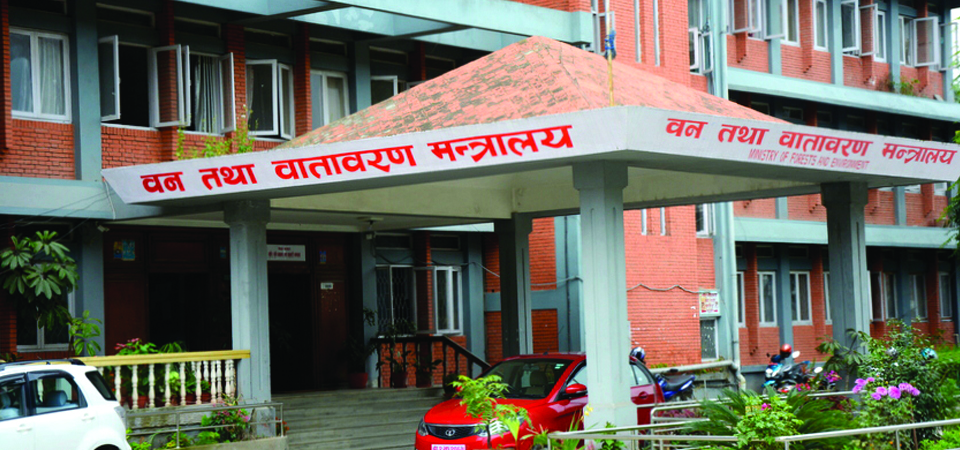Ministry plans to change forest mgmt method

By A Staff Reporter
Kathmandu, Jan. 25: The Ministry of Forest and Environment is planning to implement the Sustainable Forest Management National Plan (SFMN) by replacing the existing Scientific Forest Management (SFM) Programme, in light of its adverse impact on environment.
SFM, which has been implemented since 2017, has come under fire for its impractical method of timber harvesting.
It initially focused on sustainable timber production and meeting economic objectives, but lately it has drawn lots of criticism, because the programme is focused more on chopping trees for timber production than on conserving the forests.
To control deforestation and maintain long-term sustainability of the forest, the Ministry, in collaboration with different stakeholders, is discussing alternatives to SFM to save trees from being felled in the areas where it has been implemented, said Minister for Forest and Environment Prem Bahadur Ale.
“We have been discussing alternatives to scientific forest management to save the forest of Nepal as reflected in the slogan “Hariyo Ban Nepalko Dhan (the green forest is the wealth of Nepal),” Minister Ale said.
A Sustainable Forest Management Action Plan (SFMAP) is the best way of managing the forests according to the principles of sustainable development. The SFM has to maintain a balance between ecological, economic and socio-cultural aspects.
It also aims at providing collective benefits to all -- ranging from local livelihoods, maintaining biodiversity and ecosystem services, reducing rural poverty to mitigating the effects of climate change.
Thakur Bhandari, secretary at the Federation of Community Forest Users, Nepal (FECOFUN), said that they had been protesting against the SFM right from its inception in 2017. He said, “The SFM was introduced in the interest of a few people, including timber contractors, and it has never been in favour of community forests users’ group.”
The SFM should focus on environmental protection, social and economic factors of the society, but it somehow seemed to be guided by timber trade.
According to Bhandari, the SFM programme was against sustainable forest management of Nepal. “We have been continuously lobbying the government for replacing the SFM programme with a new one,” he said.
“Every community forest where the programme has been implemented will be divided into 80 plots, of which only one can be cut down in a year for timber trade. But a plan to cut down sal tress grown in 80 plots in 80 years is totally unfair and that might invite deforestation,” he said.
SFM has been implemented in Nepal since 1994, soon after formulation of regulations of Forest Act 1992.
Bhandari said that the SFM has been implemented in the Chure area as well and millions of good sal trees there have been chopped down in the name of the SFM programme.
There are 22,266 community forests in Nepal and 2.9 million households have been engaged in the community forest programmes. Currently, the SFM programme has been implemented in only 756 of the total community forests across the country.
The government also established a committee in the past year to study the SFM Programme.
The committee presented a detailed report on such forests in Sindhuli, Sarlahi, Rautahat, Bara, Parsa and Nawalparasi districts, alongside the report on small forests of Kapilbastu, Banke, Kailali and Kanchanpur districts.
According to the report, deforestation and economic mismanagement thrived after the implementation of the scientific forest management programme.
Recent News

Do not make expressions casting dout on election: EC
14 Apr, 2022
CM Bhatta says may New Year 2079 BS inspire positive thinking
14 Apr, 2022
Three new cases, 44 recoveries in 24 hours
14 Apr, 2022
689 climbers of 84 teams so far acquire permits for climbing various peaks this spring season
14 Apr, 2022
How the rising cost of living crisis is impacting Nepal
14 Apr, 2022
US military confirms an interstellar meteor collided with Earth
14 Apr, 2022
Valneva Covid vaccine approved for use in UK
14 Apr, 2022
Chair Prachanda highlights need of unity among Maoist, Communist forces
14 Apr, 2022
Ranbir Kapoor and Alia Bhatt: Bollywood toasts star couple on wedding
14 Apr, 2022
President Bhandari confers decorations (Photo Feature)
14 Apr, 2022










